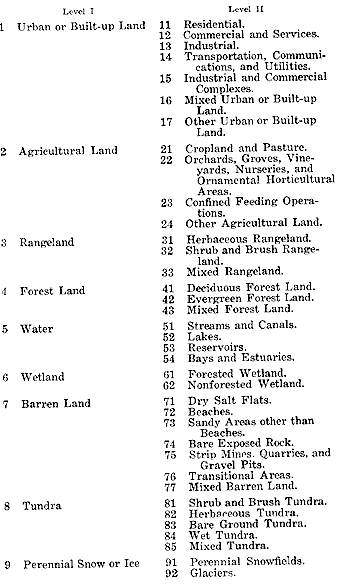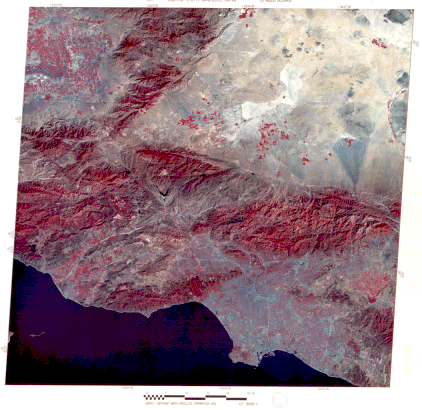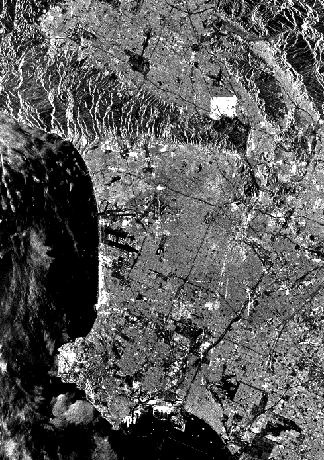
As strongly hinted at in the first three sections, space imagery (and aerial photography as well) is a powerful medium for mapping what's at the Earth's surface. The various natural and man-developed features can be identified and categorized in terms of land cover. The term land use is almost a synonym, but refers specifically to features that describe how the land has been utilized through human activities. Land cover/use maps are an essential input to Geographic Information Systems, described in detail in Section 15. Most such maps follow some classification system: one in frequent use is that developed by James Anderson and colleagues at the U.S. Geological Survey. This hierarchical system extends through four levels, the two higher ones involving categories that can usually be identified - and hence mapped - in space images whereas aerial photos are needed for Levels III and IV. This classification through Levels I and II is shown here:

To illustrate the subdivisions at the Level III stage, the I = Urban - II = Residential categories would include at III these further units = Single-Family; Multi-Family; Mobile Homes; Hotels/Motels; Other. Generally, the finer the breakdown, the more on-site ground truth information will be needed. Maps for Levels I and II can be colorized. Numerical symbols (e.g., 115 = Residential Hotels) can be added for individual features on maps at large enough scales to fit this amount of detail.
An example of a typical land cover/use map derived from Landsat imagery is this multi-theme classification covering an area surrounding Harrisburg, PA. The city itself is located by the prominent yellow pattern assigned to "urban". Smaller yellow blotches to the east and west are indications of downtowns in places such as Carlisle, Hershey, and Lebanon. This metropolitan area, with a population exceeding 300,000, is generally spread out beyond the concentration in Harrisburg itself. The legend category called "deforestation" describes the same Gypsy Moth defoliation reviewed in Section 3.
Because much of the U.S. and world populations are concentrated in and near metropolitan centers, we shall concentrate in this Section on urban land uses. Major metropolitan areas can be sprawling, often occupying a significant fraction of a full Landsat scene (although on a world scale, such areas comprise less than 10% of the land surface). This is certainly the case in one of the largest (areawise) urban regions in the world - the Los Angeles megatropolis - as seen in a resampled (lowered resolution) MSS image that extends over much of southern California.

Major geographic features in this image include: the western Mohave Desert (containing the Edwards Air Force Base), the southern tip of the Great (San Joaquin) Valley, the Tehachapi mountains on the north, extending from the southern tip of the Sierra Nevada, the several Transverse Ranges northward of L.A., bounded sharply on the north by the infamous San Andreas fault and on the south by the Santa Monica and San Gabriel Mountains. Los Angeles itself (lower right) lies within a structural basin, forming a lowlands that restricts air circulation and is a natural trap for pollutants (the famed L.A. smog).
The urban signatures in a false color composite are clearly evident in the segment of the image containing a part of the numerous cities and suburbs making up the greater Los Angeles regional sphere of influence. The areas of higher population density are highlighted by two dominant color themes: thin, usually blue to almost black, linear criss-crossing patterns representing streets and roadways; and areas in between that are also usually some shade of blue, these being the spectral expression of buildings which tend to be reflectively brightest in the blue and green bands. Interspersed within these areas are patches of red which correspond to city and town parks, cemeteries, golf courses, and pockets of intraurban agricultural fields. Residential areas often have color signatures ranging from brown to pink to mild red, stemming from the mix of lawns and trees with houses and streets. In the Los Angeles hills and neighboring mountains, signs of people's habitats and neighborhood centers are hard to recognize owing to the dominance of trees and brush that swamp those areas with reds; the Palos Verdes Estates section on the ocean is a good example. However, bands and patches of blue in the valleys, such as in the Santa Clara valley east from Ventura, attest to commercial concentrations along highway strips.
Urban areas are also expressed in quite distinctive ways in radar imagery as is clearly evidenced in this 1978 Seasat image (see Section 8 for a description of this satellite and a review of radar interpretive principles) that covers much of the western side of the Los Angeles metropolitan area. To aid in recognizing landmarks within the image, we have included a segment of the 1989 Rand McNally atlas map that locates roadways, towns, and other features in the urban infrastructure.

Many of the dark linear features in this radar image correspond to Interstates and other major roadways. The two dark narrow strips at right angles to the ocean along the middle of Santa Monica Bay are related to runways at Los Angeles International Airport. These dark patterns are caused by specular (smooth) reflecting surfaces that deflect most of the radar beam away from the receiving platform. Generally, buildings return much of the radar signal, giving rise to an intermediate gray tonal signature (uniform here because most individual buildings are not resolved). Very light patterns are associated with high levels of backscatter caused, in some instances, by stands of vegetation. This may be the case for the light pattern along the west coast of the Palos Verdes peninsula, a luxuriant residential area. However, the very bright, squarish pattern at the east end of the Santa Monica Mountains that extends into the San Fernando Valley below Burbank is rather mysterious. It approximately coincides on the map with Griffith Park north of Hollywood but its position relative to roadways discernible in the radar image indicates an inexact fit (possibly an effect of non-rectification).
Even the lower resolution subscenes created from MSS images are effective ways of manifesting the major features of urban areas, such as street patterns, large buildings, airports, recreational parks, and some industrial facilities. This is certainly evident in this March 30, 1975 MSS view of the central parts of San Diego in southernmost California which shows the Bay harbors, military and civilian airports, the downtown, Balboa Park, Mission Bay, and Cabrillo Point.
But, the value of much higher resolution to discernment of metropolitan features down to the individual building scale is convincingly revealed by this November 22, 1968 SPOT image of inner San Diego in which the three multispectral HRV band images, at 20 m (66 ft) resolution are combined and registered with the 10 m (33 ft) panchromatic image taken simultaneously. The details that stand out in this image are persuasive proof that civilian space imagery can match at least the smaller scale aerial photos in clarity and information content.
We now look at another major western urban area located in a somewhat different setting. Much of the city of Tucson, Arizona - displayed here in a Landsat TM False Color Composite subscene extending about 58 km (36 miles) east-west - sits within nearly flat terrain wedged in by several large alluvial fans from the southeast and north (the latter actually is becoming a major residential suburb, noted for fine homes midst dissected canyons) built up from stream flowing coming off the surrounding mountains.
Many prominent wider streets criss-cross the town, being laid out on the surveyor's section (1 square mile) lines in the Township System. The Santa Cruz river, north-south, is joined from the east by Rio Rillito just north of the central city. Tucson's International Airport is situated to the south, about 5 miles from the Davis-Monthan Air Force Base to its northeast. North of the city are the Santa Catalina Mountains, rising to 2800 m (9181 ft) at Mt. Lemmon where citizens of this desert town in a basin around 825 m (2500 ft) in altitude can ski in the winter. The tip of the Rincon Mountains touches the eastern reaches of the city; the scattered hills of the Tucson Mountains extend to the west. Copper mining is a major regional industry as evidenced by the dark fan-shaped lake and the bluish-white open extraction pits of the Pima Mission Mines to the south.
Code 935, Goddard Space Flight Center, NASA
Written by: Nicholas M. Short, Sr. email: nmshort@epix.net
and
Jon Robinson email: Jon.W.Robinson.1@gsfc.nasa.gov
Webmaster: Bill Dickinson Jr. email: rstwebmaster@gsti.com
Web Production: Christiane Robinson, Terri Ho and Nannette Fekete
Updated: 1999.03.15.